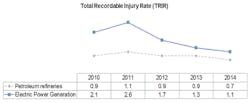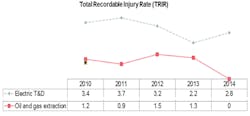Powering Continuous Improvement: Driving Safety Excellence in the Electric Power Sector
The power industry is, by nature, fraught with high-hazard potential and recognized occupational risks. Thanks to the collective efforts of industry players and associations alike, the sector has gone through a steady year-over-year improvement in the frequency and severity of employee and contractor injuries and fatalities. This is certainly an achievement worth celebrating.
Furthermore, conversations with industry leaders continue to express a commitment to safety. Increasingly, however, there is a perceived state of contentment with the results achieved, combined with a perception that the industry has reached acceptable safety performance. Looking beyond the boundaries of the electric power sector, however, one can argue that there still is a lot that needs to be done to reach the only acceptable goal of zero injuries.
Safety Performance: The Electric Power Sector in the Context of Other Hazardous IndustriesThere is no better way to challenge a state of contentment than to look beyond the established industry boundaries and benchmarks. A look at the safety performance of other hazardous industries – such as oil and gas or mining – should be sufficient to take a pause, trigger discussions and recalibrate efforts. According to the Bureau of Labor Statistics, the electric sector total recordable injury rates lag behind those of the oil and gas sector and track more closely those of the mining industry.
Some safety experts would argue that the risk profile of industries such as oil and gas and mining is higher than that of the combined electric power sector due to the operational complexities involved (with the notable exception of nuclear generation).
The electric power sector should, at minimum, seek to achieve functional safety performance and key performance indicators comparable to the oil and gas industry’s performance. The performance of the oil and gas industry constitutes, therefore, a worthy, external benchmark for the electric power sector to follow as it looks for further improvements in this ever important area.
The benefits of using a safety benchmark outside of the electric sector are further exemplified once we start to break down the sector into its two main subsectors: power generation and transmission and distribution.
Safety Performance of Petroleum Refineries Versus the Power Generation Sub-Sector
A recently retired senior executive who was responsible for overseeing a successful improvement in safety performance at a leading U.S. power company told us in an interview, “I feel much safer in a power generation plant than I would in a refinery. The processes that refineries handle are much more complex and dangerous.” While that statement may appear to be correct based on common knowledge, the reality is that according to the year-over-year injury recordable rates, it is safer in a petroleum refinery than in a power generation plant.
Notwithstanding the laudable improvement in the total recordable injury rates in the electric power generation subsector for the last five years, chart 2 (above) shows the existing room for improvement in the quest to zero injuries. The retired executive’s statement on the other hand, exemplifies an erroneous notion, prevalent among many, that the electric sector has better safety performance than the oil and gas sector.
Looking deeper, there appears to be some quick-win opportunities for improvement.
During the five-year period ending in 2014, 37 percent of the fatalities in power generation occurred at fossil fuel facilities, the facilities in which the processes most resemble those of the oil and gas and petrochemicals industries.
By applying in the fossil fuel fleet the proven safety methodologies developed in the plant-based environments of the petrochemical and the oil and gas industries, we find perhaps the most straightforward way of improving the safety performance of the electric industry in the United States.
The Transmission and Distribution Subsector Safety Performance Lags Behind Oil & Gas Extraction
While the primary operational processes involved in oil and gas extraction differ from those of the transmission and distribution subsector, there are two important similarities: processes in both sectors engage discrete and ongoing construction activities in often inhospitable environments, and most importantly, they both utilize distributed workforces with hindered opportunity for hierarchical supervision.
It should not be surprising then that the injury rates in these types of operational environments are higher than those in plant-based environments such as power generation plants and petroleum refineries. Against this backdrop, the measured achievement of the oil and gas extraction sector in 2014 is remarkable: a zero total Recordable injury rate (TRIR). This proves the point that even in the most challenging environments it is possible to have zero injuries.
From our experience consulting with oil and gas clients across the world, here is one learning that we would like to highlight in this context: behavioral safety management systems often are not enough to gain measured safety performance improvements in distributed workforces. In these environments, it becomes necessary to win the hearts and minds of the direct workers, and – even more challenging – of the contracted workforce.
Our experience in the transmission and distribution subsector shows that contrary to what many would believe, most accidents happen when workers are performing routine tasks on a normal day, as opposed to those days in which there is a coordinated response to significant weather events or an emergency. This fact exemplifies the limitations of behavioral-based safety protocols.
The emerging field of affective-based safety, which informs its approach from the latest neuroscience developments and emphasizes the impact of emotions on risk perception and risk behaviors, offers a path forward toward reaching the goal of zero in the most challenging environments, like electric transmission and distribution. In appealing to the emotional brain, subtle but very important changes in behavior can mean the difference between a day that goes according to plan or one that results in the hardest phone call a business leader can make.
It also is noted that the electric power industry has been making efforts to achieve success in this area, albeit inconsistently. Often these affective-based safety practices are embedded in other, larger programs being deployed within utilities such as Lean/Six Sigma or human performance initiatives. A focused effort, however, can drive improvements in sustainable safety performance.
The Ongoing Transformation of the Electric Sector Modifies its Risk Profile
Unfortunately, these improvements are coming as the electric power sector in North America is experiencing what some refer to as “disruptive change.” Some of the most pressing factors include far-reaching environmental legislation, the need to modify the generation mix and adopt novel technologies, the growth of distributed generation, the rise of the smart grid and a rapidly aging workforce. There also is a 300 percent increase in the planned capital expenditure over the next 20 years to create, modify or upgrade aging infrastructure. While there has been a lot of discussion about the business impact of these trends, there has been little said on how these factors collectively modify the risk profile of the industry, the possible repercussions and the strategies needed to address them.
For example, to meet ever more stringent environmental regulations, scrubbers are being added to the established coal plant fleet. This addition modifies the material process safety-risk profile of the operation in a way the power industry is not accustomed to handle. This is another good reason to learn from adjacent industries: violent chemical reactions with explosive force, pressure vessel explosions, volatile toxic chemical releases, corrosive chemical loss of containment and low-oxygen atmospheres are risks that are well documented in other industries, and now will become more prevalent in the redefined operational profile of the electric power sector.
This, however, further emphasizes the risk of having a perception of achieving “world-class safety” within the industry. Complacency ultimately can lead to not recognizing the rapidly changing risk profile and can lead to a sudden degradation in safety performance.
Importing Learnings from the Nuclear Industry: A Word of Advice
Another observed trend relates to the electric industry’s desire to apply the protocols developed by the nuclear industry to the fossil fuels fleet, and even to the transmission and distribution sector, in the hopes of replicating its excellent safety record.
A word of caution with respect to this trend: leveraged learning from one subsector to another needs to be carefully implemented. The often-overlooked factor in this equation is that the operational culture in a nuclear operation often is very different than the operational culture in fossil fuels plants and the transmission and distribution sector.
The nuclear industry is a highly regulated one. Its culture often resembles the top-down approach and process rigor of the military. Not surprisingly, many nuclear facilities are well staffed with people with military experience; this type of culture has served them well.
Most fossil fuels plants and the transmission and distribution sector, however, generally do not have the levels of staffing or redundancies to fully execute programs in similar ways. Therefore, they must be reviewed, scrutinized, and modified to meet the unique culture of their own sector while preserving the intent and integrity of the safety control being leveraged from the nuclear industry.
The underlying role of a company culture on safety performance cannot be emphasized enough. DuPont has developed one of the most cited models to explain the relationship between culture and safety performance: the DuPont Bradley CurveTM. This model helps us understand how the development of an interdependent culture – one in which safety is understood as a personal choice and responsibility and everybody becomes each other’s keeper – fosters a reduction in injury rates. The further right you go on the x-axis (cultural interdependence), the further down you go on the y-axis (injury rates). Interestingly, while the nuclear industry injury rates are very low, its culture is largely a dependent culture reliant on supervision and regulations.
How Close Is the Next Injury or Fatality?
Fatalities and injuries are discrete events whose probability of occurrence is not well defined by recordable rates alone. In order to foster a culture of continuous improvement toward zero injuries, the best question to ask is not how close to zero our recordable rates are, but how close are we to having one injury or one fatality? This simple question asked by executive management is capable of triggering an entire set of required analyses of the risk profile of the operation.
Additional, more granular questions could include:
- Have there been important changes to the generation assets recently?
- Are we testing or implementing new technologies for the first time?
- Do the refurbishments to the old asset base materially change their risk profile?
- What are our collective capabilities around process safety management?
- Are we expected to undergo, or are we undergoing, major capital projects?
- Are our newer employees learning quickly and efficiently enough?
- How are we ensuring the safety of our distributed workforces?
Within this context, the work that the Edison Electric Institute has done with the introduction of the Serious Index and Fatality Index is worth noting and a step in the right direction. Given the multiple changes that the sector is going through, and despite the robust protocols that are already in place, a renewed emphasis on risk identification is required in order to avoid unfortunate events.
The electric power sector continues to improve year-over-year in injury rates, and has achieved unprecedented success. That said, there are significant external pressures that are introducing new and real risk into the system. Executives should consider re-emphasizing the continuous improvement nature of safety and incorporating learning from adjacent industries. Furthermore, programs should be designed to independently address serious injuries and fatalities, incorporate state of the art techniques, and continuously strive for the goal of zero workplace injuries.
About the Authors: H. Ricardo Moreno, Richard Eagles and Martin Kris are with DuPont Sustainable Solutions (DSS), a leading provider of world-class operations consulting services to help organizations transform and optimize their processes, technologies and capabilities. DSS has implemented over 100 consulting projects with the electric power sector in North America.




